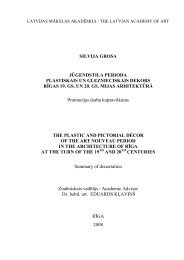Institute of Art History of the Latvian Academy of Art Anna Ancāne ...
Institute of Art History of the Latvian Academy of Art Anna Ancāne ...
Institute of Art History of the Latvian Academy of Art Anna Ancāne ...
You also want an ePaper? Increase the reach of your titles
YUMPU automatically turns print PDFs into web optimized ePapers that Google loves.
uilding with a symmetrical façade composition, large windows and<br />
lavishly decorated portal. In 1679 <strong>the</strong> penitentiary (Zuchthaus) was also<br />
built; it demonstrated a similar type <strong>of</strong> public building on a smaller scale.<br />
Since <strong>the</strong> 1670s massive building activity <strong>of</strong> large storehouses, <strong>of</strong>ten in<br />
<strong>the</strong> city centre, was on <strong>the</strong> rise. No regulations on this issue were passed;<br />
as a result, storehouses <strong>of</strong>ten ended up next to dwelling houses. Ei<strong>the</strong>r <strong>the</strong><br />
gable or <strong>the</strong> cornice <strong>of</strong> storehouses faced <strong>the</strong> street; both types were<br />
equally common in Riga. Storehouses <strong>of</strong> <strong>the</strong> rich merchants stood out by<br />
<strong>the</strong>ir representative façade solutions with <strong>the</strong> natural stone finish and<br />
sculpturally decorated portals. Extensions <strong>of</strong> <strong>the</strong> main facades were<br />
extremely wide-spread, housing shops and taverns; this influenced <strong>the</strong><br />
urban space. In <strong>the</strong> late 17 th century, detached rows <strong>of</strong> shops also<br />
appeared along with <strong>the</strong> built-in shops, <strong>of</strong>ten next to <strong>the</strong> main entrance<br />
roads <strong>of</strong> <strong>the</strong> city.<br />
IV. TYPES OF DWELLING HOUSES IN RIGA DURING THE 2 ND<br />
HALF OF THE 17 TH CENTURY<br />
IV. 1. Innovations in <strong>the</strong> construction <strong>of</strong> dwelling houses and general<br />
description<br />
Three main types <strong>of</strong> dwelling houses have resulted from <strong>the</strong> research:<br />
a) side-gabled houses with <strong>the</strong> side <strong>of</strong> a gabled ro<strong>of</strong> facing <strong>the</strong> street; b)<br />
front-gabled houses with <strong>the</strong> gable facing <strong>the</strong> street; c) combined<br />
intermediate forms in <strong>the</strong> space between ramparts after 1689. About <strong>the</strong><br />
mid-century a balance between <strong>the</strong> side-gabled and front-gabled buildings<br />
is present, but <strong>the</strong> two types are sometimes difficult to take apart, as<br />
buildings at street corners could have both facades equally elaborated.<br />
Among <strong>the</strong> average buildings <strong>the</strong>re are examples not fitting in <strong>the</strong><br />
previous period but not yet complying with <strong>the</strong> new building type. The<br />
building at 10 Laipu Street (drawing from 1650) illustrated <strong>the</strong> possible<br />
transformations <strong>of</strong> various building types on <strong>the</strong> border <strong>of</strong> two epochs. On<br />
<strong>the</strong> one hand, <strong>the</strong> plan depended on <strong>the</strong> location <strong>of</strong> <strong>the</strong> building plot; on<br />
<strong>the</strong> o<strong>the</strong>r hand, aes<strong>the</strong>tic considerations were significant as well.<br />
The transition process from <strong>the</strong> old structure <strong>of</strong> buildings to <strong>the</strong> new one<br />
is related to <strong>the</strong> changes brought by <strong>the</strong> Swedish rule in politics and<br />
economy as well as <strong>the</strong> overall flourishing <strong>of</strong> art and architecture in<br />
Nor<strong>the</strong>rn Europe. Riga was considerably influenced by <strong>the</strong> architecture <strong>of</strong><br />
Stockholm’s noble classes, but <strong>the</strong> major innovations came to Riga’s<br />
architecture from direct contacts with <strong>the</strong> Ne<strong>the</strong>rlands and Nor<strong>the</strong>rn<br />
Germany. With <strong>the</strong> spread <strong>of</strong> classical trends, locally conservative traits<br />
were also retained. The fire <strong>of</strong> 1677 marked a turning point in <strong>the</strong><br />
developmental dynamics <strong>of</strong> dwelling house architecture: construction<br />
activity boomed and <strong>the</strong> new principles <strong>of</strong> side-gabled houses were<br />
implemented. The second major fire broke out in <strong>the</strong> space between<br />
11












